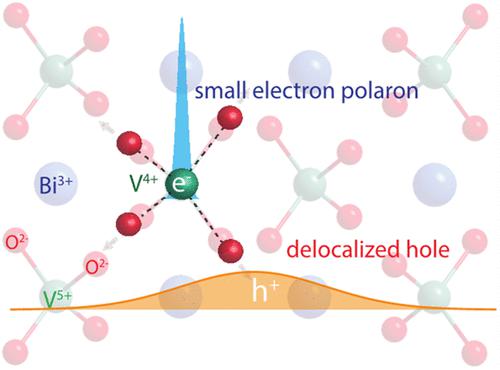当前位置:
X-MOL 学术
›
J. Phys. Chem. Lett.
›
论文详情
Our official English website, www.x-mol.net, welcomes your
feedback! (Note: you will need to create a separate account there.)
Bimolecular Self-Trapped Exciton Formation in Bismuth Vanadate
The Journal of Physical Chemistry Letters ( IF 4.8 ) Pub Date : 2022-10-13 , DOI: 10.1021/acs.jpclett.2c02596 Jinzhong Zhang 1 , Jueli Shi 1 , Yihong Chen 1 , Kelvin H L Zhang 1, 2 , Ye Yang 1, 2
The Journal of Physical Chemistry Letters ( IF 4.8 ) Pub Date : 2022-10-13 , DOI: 10.1021/acs.jpclett.2c02596 Jinzhong Zhang 1 , Jueli Shi 1 , Yihong Chen 1 , Kelvin H L Zhang 1, 2 , Ye Yang 1, 2
Affiliation

|
Bismuth vanadate (BiVO4) is a promising photoanode material for solar-driven water splitting, and knowledge of the photocarrier dynamics in BiVO4 could offer guidance to propel the development of the photoanode performance. Herein, we uncovered the nature of various photogenerated transient species in BiVO4 and extracted their respective dynamics. We found spectral and dynamic evidence that the electrons in the conduction band collapsed into severely localized small electron polarons on a subpicosecond time scale, while the holes in the valence band remained delocalized and accounted for the photoconductivity. In the following tens to hundreds of picoseconds, the electron polaron captured the hole to form a self-trapped exciton via a bimolecular reaction mechanism, and in consequence, the hole was immobilized. Our finding suggests that exciton dissociation strategies should be taken into account in the design of the BiVO4-based water-splitting applications in order to enhance charge transport and suppress charge recombination.
中文翻译:

钒酸铋中的双分子自陷激子形成
钒酸铋 (BiVO 4 ) 是一种很有前途的用于太阳能驱动水分解的光阳极材料,了解 BiVO 4中的光载流子动力学可以为推动光阳极性能的发展提供指导。在此,我们揭示了 BiVO 4中各种光生瞬态物质的性质并提取它们各自的动态。我们发现光谱和动态证据表明,导带中的电子在亚皮秒时间尺度上坍缩成严重局部化的小电子极化子,而价带中的空穴保持离域并解释了光电导率。在随后的几十到几百皮秒内,电子极化子通过双分子反应机制捕获空穴形成自陷激子,从而使空穴被固定。我们的发现表明,在设计基于 BiVO 4的水分解应用时应考虑激子解离策略,以增强电荷传输并抑制电荷复合。
更新日期:2022-10-13
中文翻译:

钒酸铋中的双分子自陷激子形成
钒酸铋 (BiVO 4 ) 是一种很有前途的用于太阳能驱动水分解的光阳极材料,了解 BiVO 4中的光载流子动力学可以为推动光阳极性能的发展提供指导。在此,我们揭示了 BiVO 4中各种光生瞬态物质的性质并提取它们各自的动态。我们发现光谱和动态证据表明,导带中的电子在亚皮秒时间尺度上坍缩成严重局部化的小电子极化子,而价带中的空穴保持离域并解释了光电导率。在随后的几十到几百皮秒内,电子极化子通过双分子反应机制捕获空穴形成自陷激子,从而使空穴被固定。我们的发现表明,在设计基于 BiVO 4的水分解应用时应考虑激子解离策略,以增强电荷传输并抑制电荷复合。











































 京公网安备 11010802027423号
京公网安备 11010802027423号